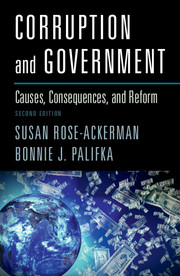Book contents
- Frontmatter
- Dedication
- Contents
- List of Figures
- List of Tables
- List of Boxes
- List of Acronyms
- Preface to the First Edition (1999)
- Preface to the Second Edition
- Acknowledgments
- INTRODUCTION
- PART I CORRUPTION AS AN ECONOMIC PROBLEM
- PART II CORRUPTION AS A CULTURAL PROBLEM
- PART III CORRUPTION AS A POLITICAL PROBLEM
- PART IV REFORM AGENDAS: DOMESTIC POLITICAL WILL AND INTERNATIONAL INFLUENCE
- 13 Domestic Conditions for Reform
- 14 The Role of the International Community
- 15 International Cooperation: States, Firms, Banks, and Organized Crime
- CONCLUSIONS
- References
- Index
13 - Domestic Conditions for Reform
from PART IV - REFORM AGENDAS: DOMESTIC POLITICAL WILL AND INTERNATIONAL INFLUENCE
Published online by Cambridge University Press: 05 March 2016
- Frontmatter
- Dedication
- Contents
- List of Figures
- List of Tables
- List of Boxes
- List of Acronyms
- Preface to the First Edition (1999)
- Preface to the Second Edition
- Acknowledgments
- INTRODUCTION
- PART I CORRUPTION AS AN ECONOMIC PROBLEM
- PART II CORRUPTION AS A CULTURAL PROBLEM
- PART III CORRUPTION AS A POLITICAL PROBLEM
- PART IV REFORM AGENDAS: DOMESTIC POLITICAL WILL AND INTERNATIONAL INFLUENCE
- 13 Domestic Conditions for Reform
- 14 The Role of the International Community
- 15 International Cooperation: States, Firms, Banks, and Organized Crime
- CONCLUSIONS
- References
- Index
Summary
Ideas and moral commitments matter. Reforms sometimes occur simply because a charismatic and committed leader pushes them through. Strong leaders can inspire people to accept major reforms that lesser personalities could never achieve. But strong leadership is generally a necessary, not a sufficient, cause of political change. Past practice creates inertia. It is often easiest to go on as before – especially because the beneficiaries of the status quo will struggle against change. Choices made at one point in time foreclose other choices in the future. However, although history imposes constraints, it seldom forces one particular outcome. The challenge is to identify structural factors, apart from charismatic leadership, that create favorable conditions for reform.
We now have sufficient experience with reform efforts throughout the world to permit some well-grounded structural observations. The argument in this chapter assumes that developing countries and those in transition can learn from the historical experience of developed countries as well as from more recent experience worldwide. Of course, the lessons will have to be filtered through the particular situation of each state, but some of the underlying political and economic incentives seem quite universal.
There are two basic models of the reform process – one based on the exercise of political power and the other based on a contractual model of consensus. Those who expect to lose from reform can be outvoted and out-maneuvered, or they can be co-opted or compensated to accept change (Grindle and Thomas 1991: 134). For example, in the 1980s Prime Minister Margaret Thatcher's government carried out administrative reforms through a conflictual strategy; in Australia Prime Minister Robert Hawke sought consensus (Zifcak 1994: 158). A key strategic decision for reformers is whom to include in their coalition and whom to force to accept the costs of reform. Should one buy off corrupt officials and private persons and firms, or should one shut them out of the reformed system? How much will reform goals be undermined by the process of generating a coalition to support change?
We begin, in Section I, with the links between the institutions of government and incentives for reform. Powerful politicians must believe that reform is in their interest. This often occurs in response to pressures by influential private groups who decide that reform will benefit them.
- Type
- Chapter
- Information
- Corruption and GovernmentCauses, Consequences, and Reform, pp. 415 - 445Publisher: Cambridge University PressPrint publication year: 2016

